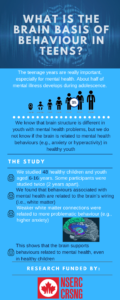
Adolescence is a period of many changes. Alongside the typical changes we associate with puberty, the brain continues to mature, and major changes in behavior may be seen. In particular, brain systems associated with internalizing and externalizing behaviors undergo significant development during this period. Internalizing and externalizing behaviors are negative behaviors directed either internally to the individual (anxiety, loneliness) or externally into their environment (aggression, hyperactivity). These behaviors are associated with mental health disorders, many of which start to appear during adolescence. The goal of this study was to examine the relationships between internalizing and externalizing behaviours and brain structure in children and adolescents without mental health disorders. By understanding these trends in healthy adolescents, we enable future studies to identify what’s different in the brain of a child who goes on to develop an internalizing or externalizing disorder.
This study analyzed 67 DTI and MRI datasets of 48 typically developing children and adolescents aged 6 to 16. We examined the volume of prefrontal and limbic structures as well as the diffusion parameters in limbic white matter. Higher internalizing and externalizing behaviour scores were associated with reduced grey matter in the prefrontal cortex (PFC) and the limbic system, as well as reduced maturity of the white matter connections linking these regions. These findings indicate that sub-clinical internalizing and externalizing behaviours are associated with white matter alterations similar to those observed in mental health disorders and suggests that alterations in the uncinate and cingulum may serve as early indicators of susceptibility to mental health disorders.